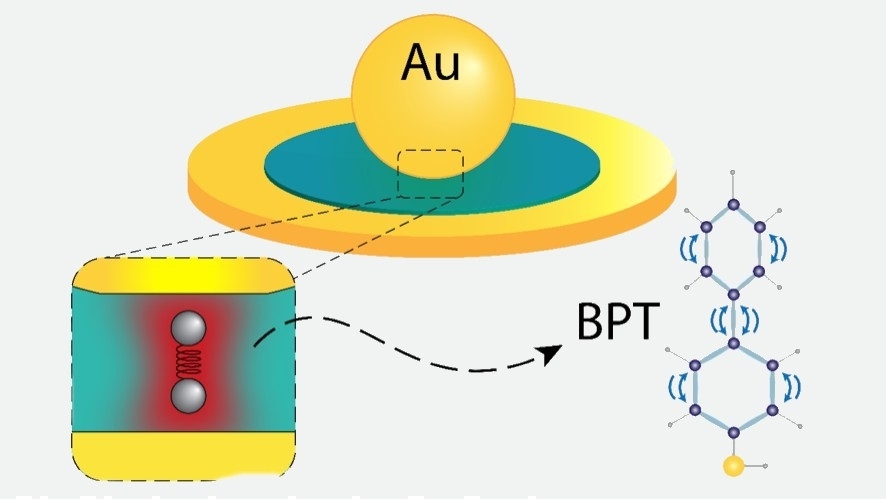

Study by researchers at the University of Campinas published in Physical Review Letters discusses both light dispersion by vibrations inside the device and light dissipation to the exterior, an aspect rarely studied hitherto (nanoparticle of gold [Au] above metal mirror, showing molecular vibration for organic molecule BPT / André Garcia Primo, UNICAMP)
Study by researchers at the University of Campinas published in Physical Review Letters discusses both light dispersion by vibrations inside the device and light dissipation to the exterior, an aspect rarely studied hitherto.
Study by researchers at the University of Campinas published in Physical Review Letters discusses both light dispersion by vibrations inside the device and light dissipation to the exterior, an aspect rarely studied hitherto.

Study by researchers at the University of Campinas published in Physical Review Letters discusses both light dispersion by vibrations inside the device and light dissipation to the exterior, an aspect rarely studied hitherto (nanoparticle of gold [Au] above metal mirror, showing molecular vibration for organic molecule BPT / André Garcia Primo, UNICAMP)
By José Tadeu Arantes | Agência FAPESP – Optomechanical microcavities are extremely small structures with diameters of less than 10 micrometers (about a tenth of a human hair) inside which light and mechanical vibrations are confined. Thanks to their small size and to efficient microfabrication techniques that enable them to hold intense light energy and interact with mechanical waves, microcavities can be used as mass and acceleration sensors and in Raman scattering (a spectroscopy technique deployed to analyze materials, including gases, liquids, and solids). A sound understanding of these phenomena can contribute in future to advances in areas such as biomedicine, including the development of sensors to detect molecules that serve as cancer markers, for example.
A study conducted at the University of Campinas’s Photonics Research Center (Photonicamp), in the state of São Paulo, Brazil, investigated a less well-known process associated with optomechanical coupling, creating a theoretical model that was validated by simulations and comparisons with experimental results recorded in the literature. The researchers report the study in an article published in Physical Review Letters.
“Two independent phenomena take place in these systems,” physicist Thiago Alegre told Agência FAPESP. “On one hand, light exerts pressure on the cavity in which it’s confined. On the other, mechanical vibrations scatter the light. Interaction between the two may occur in two different ways. If the scattered light remains inside the device, the result is called dispersive interaction. If the light escapes from the cavity, it’s known as dissipative interaction.”
Alegre is a professor at the University of Campinas’s Gleb Wataghin Institute of Physics (IFGW-UNICAMP) and a researcher with Photonicamp. He was the principal investigator for the study. The lead author of the article is André Garcia Primo, who was his PhD student at the time. FAPESP supported the study via a direct doctorate scholarship awarded to Primo, and scholarships or grants for five other projects (17/19770-1, 20/06348-2, 18/15580-6, 18/15577-5 and 18/25339-4).
Professors Newton Cesário Frateschi and Gustavo Silva Wiederhecker acted as principal investigators.
Dispersive interaction is well-understood and a basis for important advances in optomechanics, such as the LIGO interferometer that detected gravitational waves in 2016, for example, but dissipative interaction has rarely been explored in experiments. “The scarcity of experiments is due mainly to the lack of a theoretical foundation capable of accounting for the strength of dissipative interaction for a given device,” Alegre said. “Our study proposes a theoretical formulation for both dispersive and dissipative interaction.”
The proposal involves perturbation theory, which assumes that the optomechanical interaction is reasonably weak so that light and mechanical vibrations can be treated independently in an initial approximation. The description of optomechanical coupling is simplified when optical and mechanical behavior are calculated separately.
“The novelty is the way we performed the last step,” Primo said. “Essentially, contrary to what has always been done, we considered the behavior of light in the device to be physically and mathematically affected by the possibility that light can escape the cavity. When we took this into account, we realized that both the dispersive and dissipative interaction could be described with a high degree of precision.”
In the final part of the study, the researchers tested their theory by means of two experimental examples that are well-documented in the literature. In one experiment, they investigated an optomechanical cavity made of silicon and showed that both interactions, the dispersive and the dissipative, were relevant to explaining the phenomena observed. “We showed that our theory accords fully with the experiment performed and can therefore be deemed a valuable instrument to obtain devices in which these unconventional phenomena are boosted,” Alegre said.
The second example involved plasmonic optomechanical nanocavities made of gold. Nanocavities confine far smaller amounts of light than microcavities and essentially behave like nanolenses. It is possible to detect the mechanical motion of individual molecules coupled with these devices. This possibility has a wide array of applications, including the detection of chemical compounds in biological media to identify substances that can indicate pathological conditions, for example. “We showed with this theory that although it had never been reported, the dissipative scattering of light by molecules is extremely important for the optomechanical phenomena in these systems,” Primo said.
Alegre added that some of the results obtained in recent experiments and not yet fully understood are correctly described when the model produced by the study he led is taken into account.
The article “Quasinormal-mode perturbation theory for dissipative and dispersive optomechanics” can be retrieved from: journals.aps.org/prl/abstract/10.1103/PhysRevLett.125.233601.
Republish
The Agency FAPESP licenses news via Creative Commons (CC-BY-NC-ND) so that they can be republished free of charge and in a simple way by other digital or printed vehicles. Agência FAPESP must be credited as the source of the content being republished and the name of the reporter (if any) must be attributed. Using the HMTL button below allows compliance with these rules, detailed in Digital Republishing Policy FAPESP.





